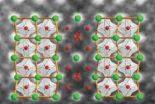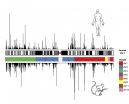(Press-News.org) Microbiologists at NYU Langone Medical Center say they have what may be the first strong evidence that the natural presence of viruses in the gut -- or what they call the 'virome' -- plays a health-maintenance and infection-fighting role similar to that of the intestinal bacteria that dwell there and make up the "microbiome."
In a series of experiments in mice that took two years to complete, the NYU Langone team found that infection with the common murine norovirus, or MNV, helped mice repair intestinal tissue damaged by inflammation and helped restore the gut's immune defenses after its microbiome had been wiped out by antibiotic therapy.
In a report on their work to be published in the journal Nature online Nov. 19, researchers say they also found that MNV bolstered the immune system in fighting off tissue damage.
"Our research offers compelling data about the mutually supportive relationship between viruses and bacteria in the mouse gut and lays the groundwork for further research on precisely how the virome supports the immune system, which likely applies to humans, as well," says senior study investigator Ken Cadwell, PhD, an assistant professor at NYU Langone.
"We have known for a long time that people get infected all the time with viruses and bacteria, and they don't get sick," says Cadwell. "Now we have scientific evidence that not every viral infection is bad, but may actually be beneficial to health, just as we know that many bacterial infections are good for maintaining health."
According to Cadwell, until now, scientists have had mostly trace genetic evidence of a virome's existence, but none to confirm its normal presence in the gut or to clarify whether it plays a harmful, neutral, or helpful role.
For their research, the team relied on their previous studies in mice genetically bred to develop inflammatory bowel disease, a condition believed to be caused by microbiome bacteria. The research showed that chronic MNV infection in these susceptible mice could produce the same inflammatory damage to intestinal tissue as chronic bacterial exposure, suggesting a similar, immune-triggering role.
In the new study, Cadwell and his colleagues fed MNV to mice bred without normal gut bacteria and whose immune systems and intestines were underdeveloped from the lack of bacterial stimuli and nutrients. Immune system T cells and B cells were lacking, and nutrient-absorbing gut projections, called villi, were shrunken and thinner than in normal mice, with smaller-than-normal surrounding tissue in the crypts between villi.
After two weeks of MNV infection, the mice, which were kept strictly isolated from exposure to any other germs, showed nearly full restoration of their immune systems and almost complete reversal of intestinal lesions.
Restorative results were similarly achieved in normal mice given MNV, whose gut microbiome had recently been wiped out by antibiotic treatment. The T cell levels in their blood doubled, and B cell antibodies were detectable in both samples of gut tissue and in the blood.
Additional tests confirmed that the MNV-mediated healing relied on increased immune system signaling by antiviral type 1 interferon proteins, confirming the virus' key role in driving the immune response.
In another series of tests designed to mimic the impact of antibiotic overuse in people and gauge any protective effects from MNV infection, researchers fed normal mice a chemical damaging to gut tissue. All mice had been previously treated with antibiotics and depleted of bacteria. Mice pretreated and infected with MNV lived longer, had longer villi and less gut tissue damage than those not infected. The MNV-infected mice also had significantly less water lost through diarrhea and less tissue overgrowth from ulcers and fluid buildup, all signs of reduced damage in the gut.
Cadwell says the team next plans to sort and characterize the health harms and benefits of other gut viruses and how each interacts or behaves differently with the microbiome. He also plans to investigate whether certain viruses are harmful or beneficial only to specific groups of people.
Cadwell also cautions that the research does not suggest that people should consider infecting themselves with any virus. As with bacteria, he says, too many of them can be hazardous to health.
INFORMATION:
Funding support for the study was provided by the National Institutes of Health grants R01 DK093668, and P30 CA016087. Additional support was provided by the Ralph S. French Charitable Foundation, the NYU Whitehead Fellowship, Vilcek Fellowship, and the Erwin Schrodinger Fellowship from the Austrian Science Foundation.
Besides Cadwell, other NYU Langone researchers involved in these experiments were lead study investigators Elisabeth Kernbauer, PhD, and Yi Ding, MD, PhD.
For more information, go to:
http://www.med.nyu.edu/biosketch/cadwek01
http://cadwelllab.med.nyu.edu/
http://www.nature.com/nature/journal/vaop/ncurrent/abs/nature13605.html
Media Contact:
David March
212.404.3528│david.march@nyumc.org
For years, scientists have considered the laboratory mouse one of the best models for researching disease in humans because of the genetic similarity between the two mammals. Now, researchers at the Stanford University School of Medicine have found that the basic principles of how genes are controlled are similar in the two species, validating the mouse's utility in clinical research.
However, there are important differences in the details of gene regulation that distinguish us as a species.
"At the end of the day, a lot of the genes are identical between a mouse and ...
For more than a century, the laboratory mouse (Mus musculus) has stood in for humans in experiments ranging from deciphering disease and brain function to explaining social behaviors and the nature of obesity. The small rodent has proven to be an indispensable biological tool, the basis for decades of profound scientific discovery and medical progress.
But in new findings published online Nov. 19 in the journal Nature, researchers at the University of California, San Diego School of Medicine and Ludwig Cancer Research, with colleagues across the country and world, have ...
TALLAHASSEE, Fla. -- A new line of research from a team at Florida State University is pushing the limits on what the world knows about how human genetic material is replicated and what that means for people with diseases where the replication process is disrupted, such as cancer.
The team, lead by Department of Biological Sciences Professor David Gilbert and post-doctoral researcher Ben Pope, has taken an in-depth look at how DNA and the associated genetic material replicate and organize within a cell's nucleus. Their work could be especially crucial for doctors and ...
BOSTON - November 19, 2014 - Each year in the Northern Hemisphere, levels of atmospheric carbon dioxide (CO2) drop in the summer as plants inhale, and then climb again as they exhale and decompose after their growing season. Over the past 50 years, the size of this seasonal swing has increased by as much as half, for reasons that aren't fully understood. Now a team of researchers led by Boston University scientists has shown that agricultural production may generate up to a quarter of the increase in this seasonal carbon cycle, with corn playing a leading role.
"In the ...
ANN ARBOR--In a study that identifies a new, "direct fingerprint" of human activity on Earth, scientists have found that agricultural crops play a big role in seasonal swings of carbon dioxide in the atmosphere.
The new findings from Boston University, the University of Michigan and other institutions reveal a nuance in the carbon cycle that could help scientists understand and predict how Earth's vegetation will react as the globe warms.
Agriculture amplifies carbon dioxide fluctuations that happen every year. Plants suck up CO2 in the spring and summer as they blossom. ...
Physicists at the University of Groningen led by Professor of Functional Nanomaterials Beatriz Noheda have discovered a new manganese compound that is produced by tension in the crystal structure of terbium manganese oxide. The technique they used to create this new material could open the way to new nanoscale circuits. Their findings were published on 20 November 2014 in the journal Nature.
The researchers grew a very thin layer (no more than a few dozen atoms thick) of the terbium manganese oxide crystal on a thicker base layer of strontium titanium oxide. This base ...
In the past years, there have often been cases of fraud in the banking industry, which have led to a considerable loss of image for banks. Are bank employees by nature less honest people? Or does the business culture in the banking sector favor dishonest behavior? These questions formed the basis for a new study by Alain Cohn, Ernst Fehr, and Michel Maréchal from the Department of Economics at the University of Zurich. Their results show that bank employees are in principle not more dishonest than their colleagues in other industries. The findings indicate, however, ...
Looking across evolutionary time and the genomic landscapes of humans and mice, an international group of researchers has found powerful clues to why certain processes and systems in the mouse - such as the immune system, metabolism and stress response - are so different from those in people. Building on years of mouse and gene regulation studies, they have developed a resource that can help scientists better understand how similarities and differences between mice and humans are written in their genomes.
Their findings - reported by the mouse ENCODE Consortium online ...
Cold Spring Harbor, NY - An international team of researchers led by Professor Thomas R. Gingeras of Cold Spring Harbor Laboratory (CSHL) and Roderic Guigo (Centre For Genomic Regulation, Barcelona) has identified some 6600 genes whose level of expression varies within a comparatively restricted range in humans and mice.
This constraint in expression, they found, is unrelated to the degree of similarity of their gene sequences. The 6600 genes represent about one-third of the total set of genes that are typically active in cells across tissues in both species, irrespective ...
This news release is available in Spanish. A group of international researchers has just discovered the keys to explaining why certain processes and systems in mice, like the immune system, metabolism and stress response, are so different to those in humans. The scientists have detailed the functional parts of the mouse genome and have compared them with those in humans. A whole set of data has come out of this - which is now to available to the scientific community - which will be significant for research into mammalian biology as well as the study of human illness ...

